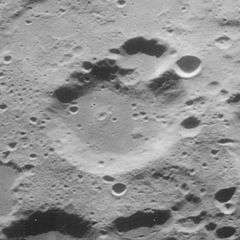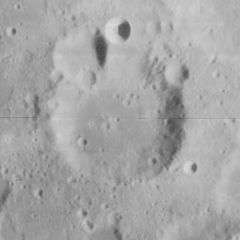Fraunhofer (crater)
|
Lunar Orbiter 4 image | |
| Coordinates | 39°30′S 59°06′E / 39.5°S 59.1°ECoordinates: 39°30′S 59°06′E / 39.5°S 59.1°E |
|---|---|
| Diameter | 56 km |
| Depth | 1.5 km |
| Colongitude | 302° at sunrise |
| Eponym | Joseph von Fraunhofer |

Fraunhofer is a lunar crater that is located just to the south-southwest of the walled plain Furnerius, in the southeastern part of the Moon. This crater appears foreshortened when viewed from the Earth, and is actually nearly circular.
This crater has undergone some erosion from lesser impacts, particularly along the northern part of the rim. The satellite crater Fraunhofer V lies along the northwestern edge and part of the inner wall. A pair of smaller craters also lie along the northern rim. The remainder of the rim is relatively intact, with small craterlets along parts of the inner wall. The interior floor is nearly level and is marked by a several small craterlets. The southern two thirds of the floor has a slightly lower albedo than the northern part.
Satellite craters
By convention these features are identified on lunar maps by placing the letter on the side of the crater midpoint that is closest to Fraunhofer.
| Fraunhofer | Latitude | Longitude | Diameter |
|---|---|---|---|
| A | 39.6° S | 61.7° E | 29 km |
| B | 41.8° S | 67.3° E | 36 km |
| C | 42.9° S | 64.7° E | 38 km |
| D | 43.1° S | 69.0° E | 17 km |
| E | 43.4° S | 61.7° E | 42 km |
| F | 41.7° S | 59.8° E | 16 km |
| G | 38.5° S | 58.3° E | 11 km |
| H | 40.8° S | 61.7° E | 43 km |
| J | 42.4° S | 63.6° E | 63 km |
| K | 42.5° S | 69.3° E | 16 km |
| L | 42.1° S | 68.8° E | 8 km |
| M | 40.9° S | 65.6° E | 21 km |
| N | 40.9° S | 64.4° E | 12 km |
| R | 43.5° S | 68.7° E | 11 km |
| S | 43.1° S | 69.9° E | 13 km |
| T | 37.9° S | 55.7° E | 8 km |
| U | 40.2° S | 65.1° E | 24 km |
| V | 39.0° S | 58.0° E | 24 km |
| W | 39.4° S | 62.8° E | 18 km |
| X | 39.7° S | 60.6° E | 6 km |
| Y | 40.2° S | 63.0° E | 13 km |
| Z | 39.9° S | 63.9° E | 14 km |
References
- Andersson, L. E.; Whitaker, E. A. (1982). NASA Catalogue of Lunar Nomenclature. NASA RP-1097.
- Blue, Jennifer (July 25, 2007). "Gazetteer of Planetary Nomenclature". USGS. Retrieved 2007-08-05.
- Bussey, B.; Spudis, P. (2004). The Clementine Atlas of the Moon. New York: Cambridge University Press. ISBN 978-0-521-81528-4.
- Cocks, Elijah E.; Cocks, Josiah C. (1995). Who's Who on the Moon: A Biographical Dictionary of Lunar Nomenclature. Tudor Publishers. ISBN 978-0-936389-27-1.
- McDowell, Jonathan (July 15, 2007). "Lunar Nomenclature". Jonathan's Space Report. Retrieved 2007-10-24.
- Menzel, D. H.; Minnaert, M.; Levin, B.; Dollfus, A.; Bell, B. (1971). "Report on Lunar Nomenclature by the Working Group of Commission 17 of the IAU". Space Science Reviews. 12 (2): 136–186. Bibcode:1971SSRv...12..136M. doi:10.1007/BF00171763.
- Moore, Patrick (2001). On the Moon. Sterling Publishing Co. ISBN 978-0-304-35469-6.
- Price, Fred W. (1988). The Moon Observer's Handbook. Cambridge University Press. ISBN 978-0-521-33500-3.
- Rükl, Antonín (1990). Atlas of the Moon. Kalmbach Books. ISBN 978-0-913135-17-4.
- Webb, Rev. T. W. (1962). Celestial Objects for Common Telescopes (6th revised ed.). Dover. ISBN 978-0-486-20917-3.
- Whitaker, Ewen A. (1999). Mapping and Naming the Moon. Cambridge University Press. ISBN 978-0-521-62248-6.
- Wlasuk, Peter T. (2000). Observing the Moon. Springer. ISBN 978-1-85233-193-1.
